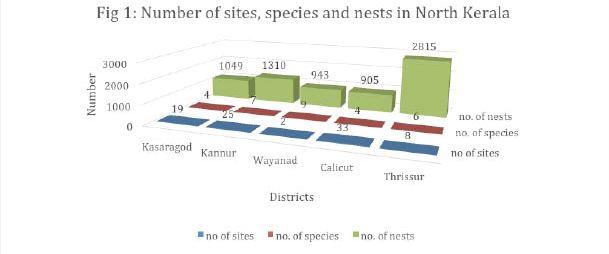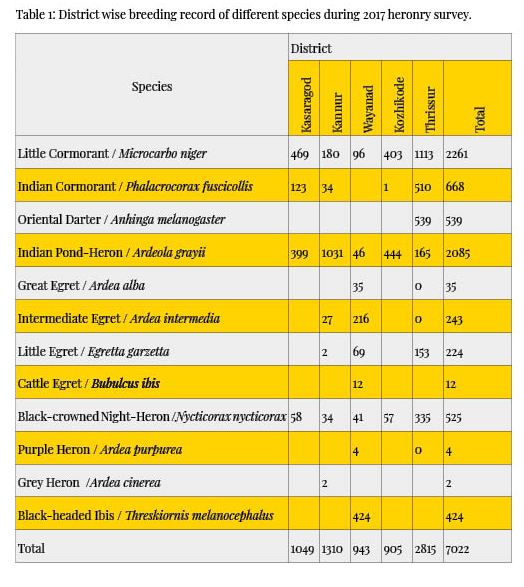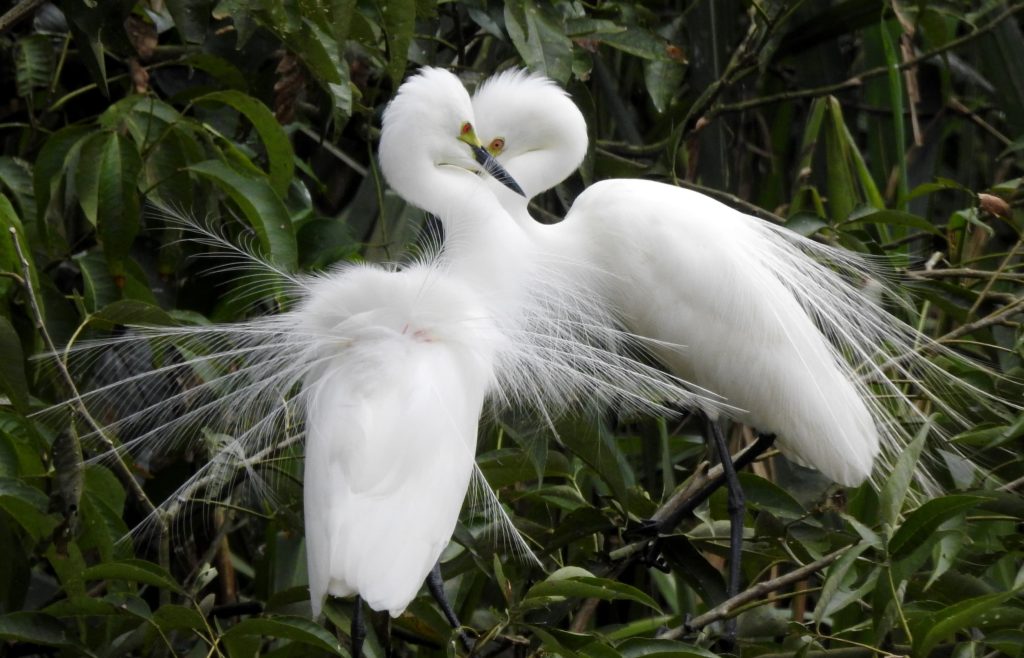Abstract
A total of 7022 nests of 12 species were were recorded from Kasaragod, Kannur, Kozhikode, Wayanad and Thrissur districts of Kerala during 2017 heronry survey. Highest number of heronry sites was recorded in Kozhikode (33), while the highest number of nests was recorded in Thrissur district (2815 nests) and the highest number of breeding species (9) from Wayanad District. Several instances of threats to the heronries were noticed.
Introduction
Heronries are nesting colonies of colonial waterbirds such as herons, egrets, cormorants, storks etc., which shows temporal and spatial clumping of nest during breeding season. Counting of colonial nests can be regarded as an effective and accurate way to determine the breeding population of water birds in an area. Being one of the top predators in the aquatic food chain, monitoring their population can indicate the health of the aquatic ecosystem, freshwater as well as brackish water. Organised heronry surveys have been carried out throughout the state of Kerala with the help of Kerala Forest Department, various NGO’s and individuals.
Methods
Methodology followed the Heronry Census of Kerala Protocol (Sashikumar et al., 2015). All the known heronries were listed first, gathering information from the previous studies (Roshnath et al. 2017). An appeal for information on the heronries was published in the local newspapers in some districts and the new heronries thus known also were added to the list. The surveys were conducted in the last week of July and the first week of August, which is the peak breeding season for waterbirds in Kerala. During the census, each heronry was visited and all information on the site location, species of nesting trees, number of nests of each species, age of the heronry, and threats if any was also recorded in prescribed data sheets.
Results
In the 2017 heronry survey, only five district of Kerala (Fig 1) were covered as the birdwatchers of most other districts were engaged in the Kerala Bird Atlas Survey programme. Highest number of heronry sites were recorded in Kozhikode (33 sites) followed by Kannur (25) and Kasaragod (19), while highest number of nests were recorded in Thrissur district (2815 nests). Highest species count (9 species) was recorded in Wayanad District.

A total of 7022 nests of 12 species were recorded during 2017 survey (Table 1). Little Cormorant Microcarbo niger (32.2%) and Indian Pond-Heron Ardeola grayii (29.7%) were the major nesting species found in most of the heronries. An increased breeding population of Indian Cormorant Phalacrocorax fuscicollis was found in Thrissur (104 nest in 2016 to 510 nest in 2017) and in Kannur (11 nests in 2016 to 34 nests in 2017). Even though the number of nests of Black-crowned Night-Heron Nycticorax nycticorax was found to have decreased in the north Kerala districts, an increased count was found in Thrissur. Compared to the previous year, Oriental Darter Anhinga melanogaster nests were 40.3% less in Thrissur district; this could be because of the cutting down of a large nesting tree (Mangifera indica) in Thrissur railway station compound which hosted large number of nests. Interestingly, an increased number of Indian Cormorant nests in the district was noticed, which may have led to competition for nest sites for Oriental Darters and this also could be a reason for their reduced breeding numbers.

Cutting down of nesting trees or branches, attempts to drive away the nesting birds via catapulting, stone pelting, bursting crackers etc. were found to be the common practices that harmed the nesting birds. Sensitising public through visual and print media, posters etc. on the ecological importance of these birds can draw public attention towards the conservation of these species. Also governmental interventions are needed for the management of such breeding and roosting sites in urban areas which support large number of waterbirds and passerine birds.
References:
Roshnath, R. Sashikumar, C., Gresham, P., Mannar, H., Sreekumar, B., Mavelikara, H and Sivakumar A.K., 2017. Kerala Heronry Survey 2016 – A Summary. Malabar Trogon 15 (3 ):41-45.
Sashikumar C., Bimalnath KG, Hari Mavelikara, Harikumar Mannar, ES Praveen, Raju S, Roshnath R, Sathyan Meppayur, B Sreekumar, A K Sivakumar, CK Vishnudas, Praveen J and Nameer P O. 2015. Heronries of Kerala – 2014. Malabar Trogon 13(2&3):2-11.
